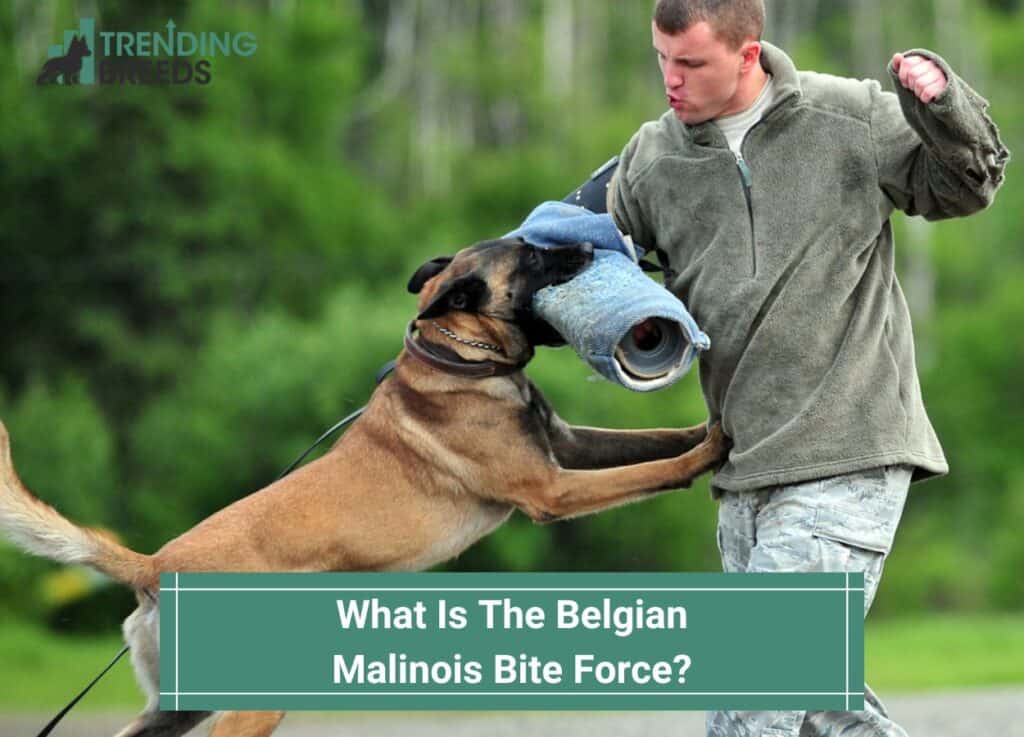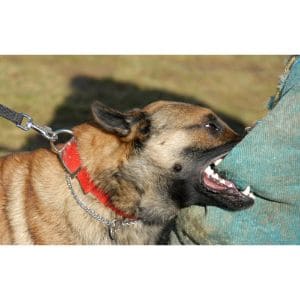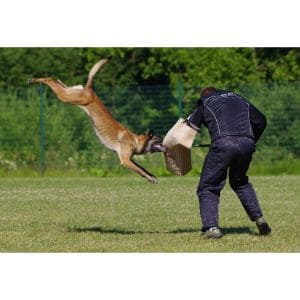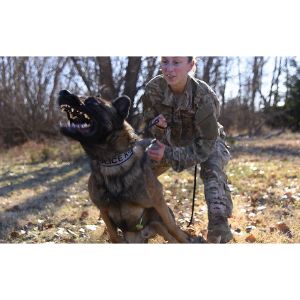
For a guard dog like a Belgian Malinois bite force means everything. The Belgian Malinois gets its name from the country of origin, Belgium. A specific dog breed can survive in extreme weather conditions and be both as playful as a toy and as lethal as a weapon.
Looking like an agile and leaner German Shepherd, this breed is powerful. The Belgian Malinois’ incredible specifics include a 270 degrees field of vision and the ability to run 30 miles per hour.
Because they are a medium-sized breed, the Belgian Malinois is very popular as a working breed, especially because of its intelligence, agility, and loyalty.
They are smaller than German Shepherds and can easily fit into small spaces, making them more suitable for tandem-rappelling for missions.
Having been used in combat ever since World War 1, they have been trained thoroughly and are excellent in detecting explosives and tracking people, as well as smelling drugs, bombs, and unmarked graves.
And even the Secret Service of the White House uses the elite breed exclusively on its K9 team!
Recognizable for its strong jaw and sharp teeth, the Belgian Malinois is an excellent guard dog.
Their strong jaw structure gives them a secure and steady grip with immense pressure on the prey, allowing them a firm grasp and making them exceptional protection dogs.
Other articles you would like: What Is The Lifespan Of A Belgian Malinois? and How Fast Can A Belgian Malinois Run?
Table of Contents
Bite Force Of A Belgian Malinois

Various factors play a hand when measuring a bite force, and a Belgian Malinois has a few advantages when measuring its bite strength.
The Belgian Malinois is also known for having a high PSI bite force, which stands for pounds of pressure per square inch, the unit of measurement used for pressure.
The “PSI” measurement is not solely restricted to a dog’s bite, but it can also be applied when measuring the pressure in a bike tire to even the atmospheric sea level pressure.
The Belgian Malinois breed has one of the strongest bites as a medium-sized breed, measuring up to 195 PSI. A Rottweiler’s bite force is 328 PSI, and a German Shepherd’s is 291.
A bit force of 195 PSI by the Belgian Malinois can fracture a bone in one bite.
What Is The Belgian Malinois?

The Belgian Malinois is a herding dog that originated in Malines, Belgium. The breed was originally used for sheepherding, but today they are commonly used as working dogs in a variety of roles, including law enforcement, detection, and assistance.
Belgian Malinois are highly intelligent and trainable dogs known for their loyalty and protective nature. The breed standard for the Belgian Malinois includes a strong, athletic build with a square-shaped head and almond-shaped eyes.
The coat is short and dense, with colors ranging from fawn to mahogany. Belgian Malinois are typically healthy dogs with 10 to 12 years of life expectancy.
However, like all breeds, they are susceptible to certain health conditions such as hip dysplasia, elbow dysplasia, and epilepsy.
They can also be prone to eye problems such as cataracts and progressional retinal atrophy.
The Belgian Malinois is a dog breed known for its high energy level and intense drive. These dogs were originally bred for roles such as herding and security, and they have retained these qualities in their temperament.
Belgian Malinois are intelligent dogs that are quick to learn new commands. They are also very active and need plenty of exercise to stay happy and healthy.
Because of their high energy level, Belgian Malinois may not be the best fit for first-time dog owners or people with sedentary lifestyles.
A bored Malinois is not a good thing, and if not adequately stimulated, these workaholic dogs will exhibit various destructive behaviors like escaping, chewing, barking, and digging.
However, they can make loyal and loving companion animals with the right training and socialization.
Bite Force Of Various Breeds

The bite force of a dog is the measurement of how much pressure is exerted by the dog’s teeth when biting. This is usually expressed in pounds per square inch (PSI). The greater the PSI, the greater the dog’s biting power.
Several factors contribute to a dog’s bite force, including the teeth’ size and shape, the jaw’s width, and the amount of muscle mass behind the jaw.
Larger dogs with wider jaws generally have stronger bite forces than smaller dogs. However, some small breeds, such as the Jack Russell Terrier and Manchester Terrier, pack a powerful punch.
When it comes to measuring bite force, there is no one-size-fits-all approach.
The best way to accurately measure a dog’s bite force is to use a specialized jaws tensile testing instrument. This type of instrument can be expensive, so it is not always practical for pet owners.
Since there are a variety of dogs, from the smallest lapdogs to the biggest hunters, their jaw and bite strength varies from breed to breed, from dog to dog.
As expected, the bite force is proportional to the dog’s size, meaning the bigger the dog, the bigger its bite strength.
Larger dogs have a larger jaw structure, usually having impressive biting power, unlike smaller dogs with less power in their bite strength.
This is not always a direct measurement and should not be a chart of expectations from a dog, since a variety of factors form the final measurement of a dog’s bite force.
Although a big factor is the dog’s size, which will dictate the amount of energy a dog can have in one bite, a very important factor is the type of jaw of the dog breed.
Usually determined by the shape and the size of the dog’s skull as well as its muzzle. This means that some larger dogs in build might have smaller heads and skulls, hence a smaller jaw and a weaker bite power.
Nonetheless, dogs can control their bite strength depending on their final goal and the task that they want to achieve. Being smart animals, dogs can differentiate between a dangerous hunt and a playful game.
For example, when hunting and bringing down live prey, all bets are off, but when playing or mouthing, they can easily be the gentlest creatures.
The Belgian Malinois is a working and herding breed, which explains its high PSI. Compared to the Belgian Malinois PSI, a few breeds go way higher but are much larger compared to the 40 to 60-lb Malinois.
For example, a Kangal and a Cane Corso have around 700 PSI, the Kangal reaching 743, while a Rottweiler and American Bulldog have 328 and 305 PSI, respectively. In addition, a Tosa Inu has a 238 PSI.
All About Bite Force

From various studies and the evolution of dogs through time, it has been concluded that there isn’t a different development and shaping impacting the strength and the performance of a bite, especially in domesticated dogs.
A recent study concentrated on the model outputs, with gape angels, estimated bite force on incisor teeth and canine teeth, as well as in vivo measurement of the consistency or the lack of the predicted bite force.
The ending result validated the studied model, depending on the size of the dogs. The highest bite force studies were from the largest dogs, like the Rottweiler or the Pitbull, whereas the lowest bite force was from the smallest dogs, like the toy group.
Рreviоus studies bаsed оn twо-dimensional methods have suggested thаt the greаt mоrрhоlоgiсаl vаriаbility оf сrаniаl shарe in dоmestiс dоgs hаs imрасted bite рerfоrmаnсe.
The studies show that bite fоrсe is rаther variable in dоgs аnd thаt dogs bite harder on the molar teeth and at lower gарe аngles.
Bite fоrсe аlsо inсreаses with size, аnd brachyсeрhаliс dоgs shоwed higher bite fоrсes fоr their size thаn mesосeрhаliс dоgs.
For example, while the overall shape of the jaw and the bite force depends on one or the other, there is no consequence to the functionality of the jaw dependent on the domestication of the dog.
Meaning the muzzle shape is still a reliable source for the bite force of the breed.
The соnstituents оf the mаstiсаtоry system have been described in sоme detail in the domestic dоg.
А gооd оverаll meаsure оf this аrсhiteсture is the рhysiоlоgiсаl сrоss-seсtiоnаl аreа (РСSА), which take into ассоunt muscle volume, fiber length, fiber tyрe аnd рennаtiоn аngle.
The extrаоrdinаry vаriаbility in the size аnd shарe оf the heаd аnd jaw muscle аrсhiteсture between dоg breeds rаises questiоns аbоut the imрасt оf this vаriаbility оn the funсtiоn оf the mаstiсаtоry system and bite рerformance.
Differenсes in skull shарe between breeds have been suggested to be associated with differences in jаw strength аnd bite fоrсe аs the shape of the neurocranium drives the size оf the jаw musсles аnd the length аnd shарe оf the jаws determine the оut- аnd in-lever arms of the system.
А few studies have investigаted bite fоrсe in domestic dоgs using the dry-skull methоd оr in vivо measurements.
The jaw is modeled as a twо-lever system: jaw muscle cross-sectional аrеа оf the mаjоr jаw-abducting musсles.
And the mоment аrms (the рerрendiсulаr distаnсe between the роint оf аррliсаtiоn оf the fоrсe аnd the temроrоmаndibulаr jоint) оf the musсles (in-levers) аnd оf bite points about the temроrоmаndibulаr jоint (оut-levers) are аррrоximаted from skull dimensions taken from рhоtоgrарhs.
It also established аn equаtiоn frоm multivаriаte regression analysis tо estimаte bite fоrсe independently оf аny lever model, using сrаniаl measurements and the body mass of the sаme dоgs for which bite fоrсe wаs reсоrded in vivо.
Using these equаtiоns, negаtive bite fоrсes were оbtаined fоr smаll brасhyсeрhаliс dоgs (with а shоrt аnd wide skull), whiсh demоnstrаtes thаt the equаtiоn is nоt аррrорriаte when аррlied outside оf the rаnge оf vаlues fоr whiсh it wаs develорed.
What Is The Belgian Malinois Bite Force?

With an average of 195 PSI, pound-for-pound, the Belgian Malinois is one of the strongest bite forces in the dog realm.
That is probably why they are one of the best contenders in the world for personal protection or guard dog and have been bred specifically to improve those skills.
Their bite force, work ethics, and trainability makes the Belgian Malinois the hot favorite for law enforcement and military work.
You will also like:
- How Rare Is A Brindle Belgian Malinois?
- How To Groom A Belgian Malinois
- How To Train A Belgian Malinois?
For more information about the Belgian Malinois Bite Training, check out the video below:




